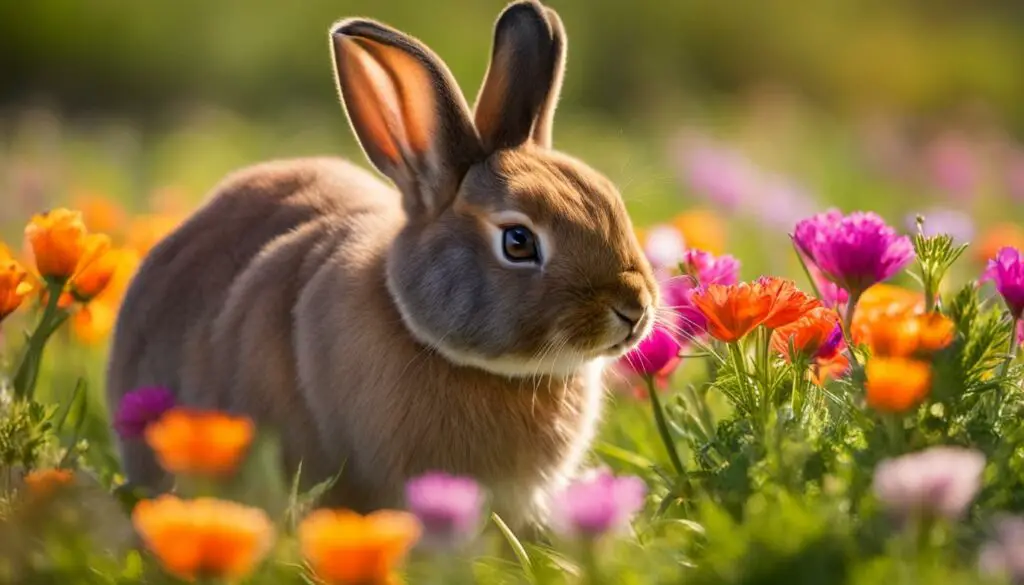Hey there! Are you a proud bunny owner or considering bringing one home? Well, you’ve come to the right place! As an avid bunny lover, I’m here to share some fun facts and essential care tips to help you provide the best care for your adorable bunny butt.
Did you know that rabbits have complex needs and require proper care to thrive? It’s true! From a healthy diet and a spacious enclosure to social enrichment and grooming, there’s a lot to learn about keeping your bunny happy and healthy.
But fret not! I’ve got you covered. In this article, we’ll dive into the importance of a healthy diet for your rabbit, setting up the perfect indoor enclosure, introducing your bunny to their new environment, and much more. So, let’s hop right in and get informed!
Key Takeaways:
- Rabbits have complex needs and require proper care to thrive.
- A healthy diet, a spacious enclosure, and social enrichment are essential for bunny happiness.
- Introduce your bunny gradually to their new environment and bond at their pace.
- Decide whether to keep your bunny indoors or outdoors based on your preferences and ability to provide appropriate care.
- Regular grooming, understanding rabbit behaviors, and providing essential products enhance your bunny’s living environment.
The Importance of a Healthy Diet for Your Rabbit
Proper nutrition plays a vital role in maintaining the health and well-being of your rabbit. A healthy diet not only provides essential nutrients but also helps prevent various health issues that can arise from poor nutrition. When it comes to feeding your rabbit, there are a few key elements to keep in mind.
The Rabbit’s Staple Diet: Hay
Rabbits are herbivores, and their diet should primarily consist of hay. The high fiber content in hay aids in digestion, prevents dental issues, and keeps your rabbit’s gut healthy. Timothy hay is a popular choice, but other options such as orchard grass or oat hay can also be included. It is important to ensure that the hay is fresh, clean, and free from dust or mold.
Table: Recommended Hay Types for Rabbits
| Hay Type | Description |
|---|---|
| Timothy Hay | A nutritious and widely available hay type that is suitable for most rabbits. |
| Orchard Grass | A slightly sweeter alternative to timothy hay that some rabbits prefer. |
| Oat Hay | A good source of fiber and variety for your rabbit’s diet. |
Leafy Greens and Vegetables
In addition to hay, rabbits should also be provided with a variety of fresh leafy greens and vegetables. These provide additional nutrients, hydration, and mental stimulation for your rabbit. Some safe options include arugula, romaine lettuce, spinach, cilantro, and carrot tops, among others. It’s important to introduce new greens gradually and monitor your rabbit’s reaction to ensure they don’t develop any digestive issues.
Pellets: Moderation is Key
Rabbit pellets can be incorporated into your rabbit’s diet, but they should be given in moderation. Pellets should make up no more than 5% to 10% of their overall diet, depending on their size and weight. Look for high-quality pellets that are specifically formulated for rabbits, as they contain the necessary vitamins and minerals. Avoid pellets with added sugars or artificial additives.
By providing your rabbit with a well-balanced diet of hay, leafy greens, and limited pellets, you can ensure that they receive the necessary nutrients for a healthy and happy life.

Setting Up an Indoor Enclosure for Your Bunny Butt
When it comes to creating a comfortable and safe environment for your bunny butt, setting up the right indoor enclosure is essential. Most pet store cages labeled as “rabbit” cages are often too small to provide adequate space for rabbits to move and explore. An ideal enclosure should allow your rabbit to hop at least three times from one end to the other, lie down comfortably, and stand on their hind legs without hitting the top.
Instead of a traditional cage, consider using a pet exercise pen or a large dog crate as a spacious enclosure for your rabbit. These options provide more room for your bunny to stretch their legs and engage in natural behaviors. Aim for an exercise space of at least 24 square feet, which can be the same room as their enclosure or a separate exercise pen. This additional space will give your rabbit the opportunity to exercise and explore their surroundings freely.
Materials for Building an Indoor Rabbit Enclosure
Building a DIY indoor rabbit enclosure can be a cost-effective and customizable option. Here’s a list of materials you’ll need:
- Wire mesh or panels: Choose a sturdy material that will prevent your rabbit from escaping or chewing through.
- Flooring: Use a waterproof material such as vinyl or linoleum to protect your floors from accidents and make cleaning easier.
- Bedding: Opt for a safe and absorbent bedding material like straw or recycled paper pellets.
- Furniture and hideouts: Provide your rabbit with hiding spots and resting areas, such as tunnels, boxes, and wooden houses.
- Food and water bowls: Choose heavy ceramic or stainless steel dishes that are difficult for your rabbit to tip over.
- Litter box: Train your rabbit to use a litter box to keep the enclosure clean and minimize odors.
Remember to rabbit-proof the area around the enclosure by covering power cords, removing toxic plants, and securing any small objects that your curious bunny might chew on.
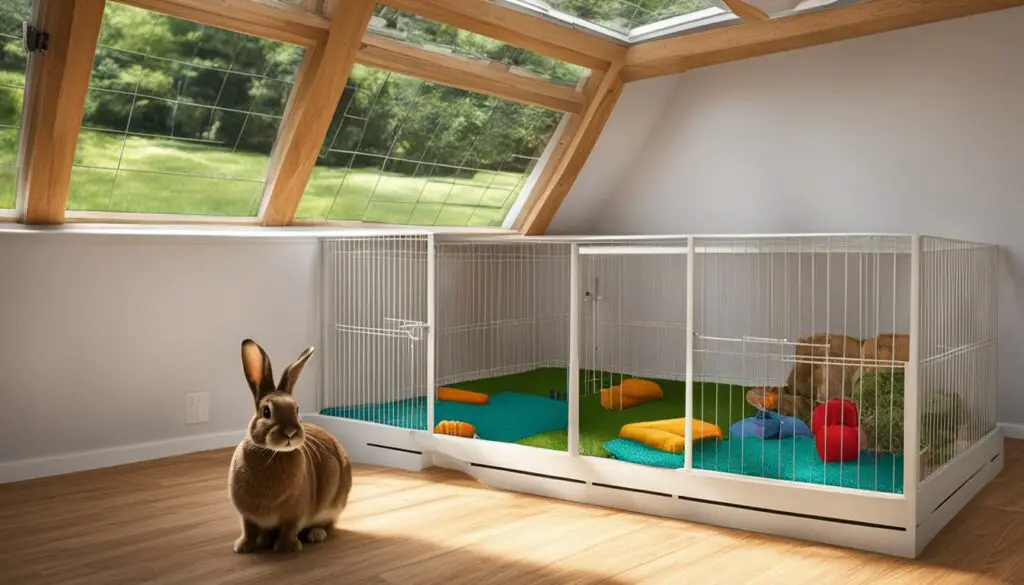
Creating a Stimulating Environment
In addition to the basic essentials, it’s important to provide your bunny butt with a stimulating environment. Include toys, tunnels, and chewable objects to keep your rabbit engaged and prevent boredom. You can also incorporate different levels in the enclosure by using ramps or platforms, allowing your rabbit to enjoy vertical space and exercise their natural jumping instincts.
Make sure to regularly inspect and clean the enclosure to maintain a hygienic and healthy space for your bunny. Keep an eye out for any signs of wear or damage to the enclosure and address them promptly to ensure your rabbit’s safety.
By setting up a spacious and enriching indoor enclosure, you’re creating a comfortable and stimulating environment for your bunny butt to thrive in. Remember to provide plenty of space, essential items, and opportunities for exercise and mental stimulation, and you’ll be well on your way to providing your rabbit with a happy and healthy home.
Bringing Your Bunny Butt Home – Introducing Your Rabbit to Their New Environment
Bringing a new rabbit home is an exciting time, but it’s important to give them the time and space they need to adjust to their new environment. The first 24 hours are crucial for your rabbit to get accustomed to the sights, sounds, and smells of their new home. During this time, it’s best to leave them undisturbed in their enclosure, allowing them to explore and settle in at their own pace.
After the initial settling period, you can gradually start interacting with your rabbit. Sit beside their enclosure, talk to them in a calm and soothing voice, and let them become familiar with your presence. This will help build trust and establish a positive bond between you and your rabbit. Remember to never rush the bonding process; let your rabbit set the pace and always respect their boundaries.
As your rabbit becomes more comfortable, you can begin to introduce gentle interactions such as softly petting them or offering them treats. However, it’s important to be patient and observant of their body language. If your rabbit shows signs of stress or discomfort, give them some space and try again later. Each rabbit is unique and will adjust to their new home in their own time.
| Introducing Your Rabbit to Their New Home | Tips for Success |
|---|---|
| Leave your rabbit undisturbed for the first 24 hours. | – Allow them to explore their enclosure and get comfortable. |
| Spend time sitting beside their enclosure and talking to them. | – Establish a calm and soothing presence. |
| Gradually introduce gentle interactions like petting and offering treats. | – Respect your rabbit’s boundaries and observe their body language. |
| Be patient and let your rabbit set the pace for bonding. | – Build trust over time and always be sensitive to their needs. |
By following these steps to introduce your rabbit to their new home, you can create a safe and nurturing environment that promotes trust and bonding. Remember, every rabbit is unique, so it’s essential to be patient, observant, and respectful of their individual needs and preferences. With time and care, your bunny butt will soon feel right at home with you!
Bunny Butt Housing – Indoor or Outdoor?
Deciding whether to keep your rabbit indoors or outdoors depends on personal preference and the ability to provide appropriate care. Indoor rabbits require rabbit-proofing the home, litter training, and dedicated social interaction. Outdoor rabbits need a secure hutch and a daily commitment to socialize with them. Providing a suitable rabbit hutch is essential, with the right dimensions and appropriate bedding.
Indoor rabbits have the advantage of being part of the family, receiving regular social interaction, and having a controlled environment. They are protected from predators, extreme weather conditions, and potential dangers of the outdoor environment. However, it’s important to make your home rabbit-proof to prevent chewed cords or toxic plants.
Outdoor rabbits can enjoy the fresh air and natural surroundings, mimicking a more natural habitat. However, they require a secure and spacious hutch that protects them from predators and extreme weather conditions. The hutch should have proper bedding to provide comfort and insulation. Additionally, daily interaction and playtime are crucial to prevent loneliness and ensure their overall well-being.
| Indoor Rabbits | Outdoor Rabbits |
|---|---|
| Requires rabbit-proofing the home | Requires a secure hutch |
| Regular social interaction | Daily commitment to socialize |
| Protected from predators and extreme weather | Exposure to fresh air and natural surroundings |
| Controlled environment | Potential dangers of the outdoor environment |
Ultimately, whether you choose to keep your rabbit indoors or outdoors, it’s important to provide them with a safe and comfortable living space. Regular monitoring and attention to their needs will ensure that your bunny butt thrives in their chosen environment.
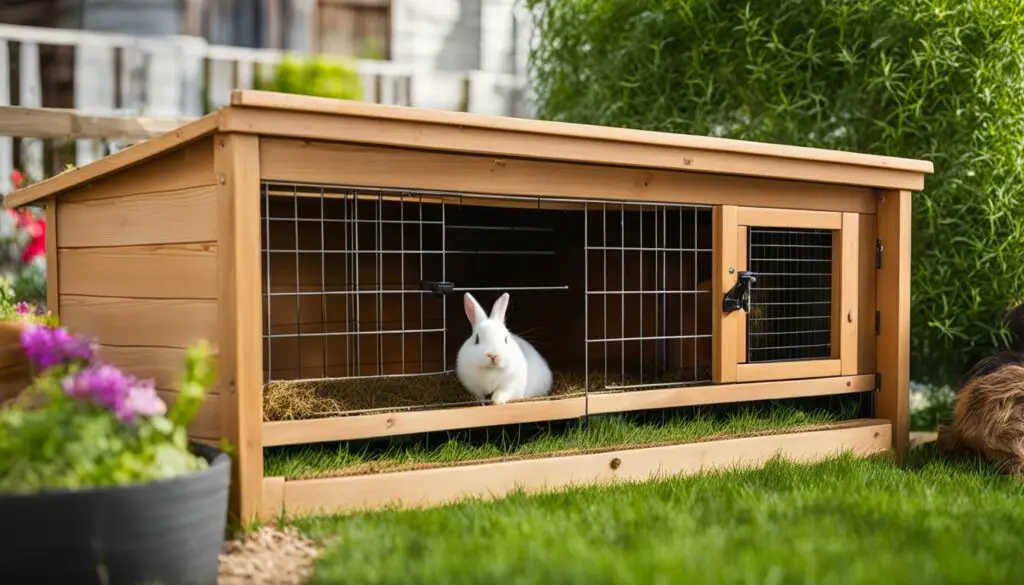
The Delicate Balance of Temperature for Your Bunny Butt
Proper temperature regulation is crucial for the health and well-being of your bunny butt. Rabbits are more sensitive to heat than cold, so it’s essential to ensure that they are kept in a comfortable environment to prevent heat stroke and other heat-related issues.
During hot weather, it’s important to provide a cool and shaded area for your outdoor rabbits. This can be achieved by creating a sheltered space with natural shade or using a cover over their enclosure. Additionally, proper ventilation is essential for indoor rabbits to prevent overheating. Ensure that their living space has adequate airflow, and avoid placing their enclosure in direct sunlight.
If temperatures rise above 90 degrees, it’s crucial to take extra precautions to keep your bunny butt cool. You can place frozen water bottles wrapped in a towel in their enclosure or provide a cooling mat for them to lie on. Monitoring the temperature regularly and taking appropriate measures will help ensure your rabbit’s safety and comfort.
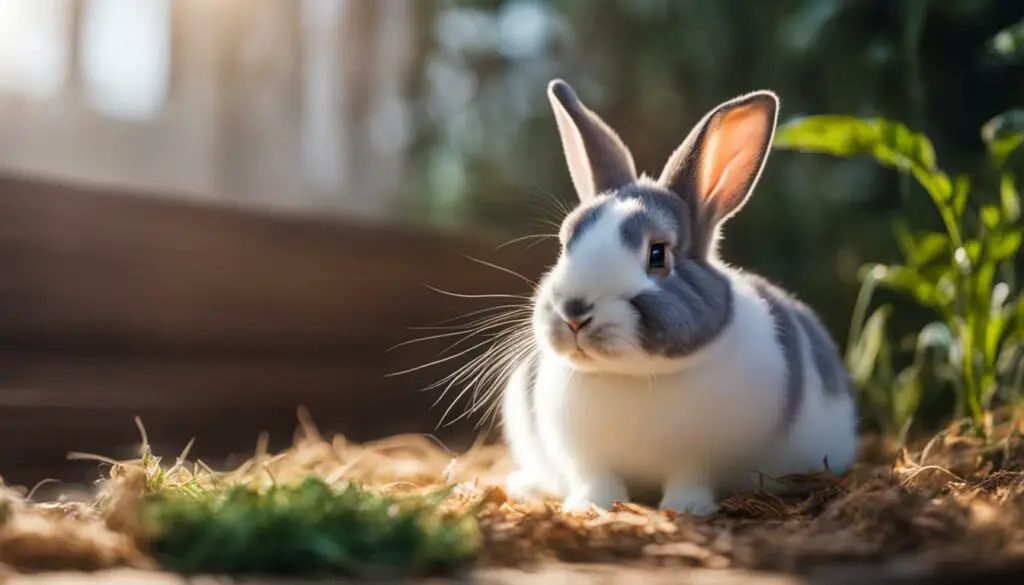
Table: Recommended Temperature Range for Rabbits
| Temperature Range | Condition |
|---|---|
| Below freezing | Tolerable but provide appropriate shelter |
| 40-70 degrees | Optimal temperature range for rabbits |
| Above 90 degrees | High risk of heat stroke and heat-related issues |
Bunny Butt Grooming – Keeping Your Rabbit Happy and Healthy
Grooming is an essential part of caring for your bunny butt, ensuring their fur stays healthy and preventing matting. Regular grooming sessions also provide an opportunity for you to bond with your rabbit. Here are some key tips for grooming your rabbit:
- Start by gently combing your rabbit’s fur to remove any loose hair. Use a soft brush to keep their coat clean and shiny.
- Take note of your rabbit’s preferences during grooming. Some rabbits enjoy being brushed, while others may need some time to get used to the sensation. Be patient and go at their pace.
- Inspect and trim your rabbit’s nails regularly to prevent overgrowth. Use a pet nail trimmer designed specifically for rabbits and be careful not to cut too close to the quick.
Keeping your rabbit’s nails at an appropriate length is crucial for their overall foot health. If you’re unsure about nail trimming, you can seek guidance from a veterinarian or a professional groomer who is experienced with rabbits.
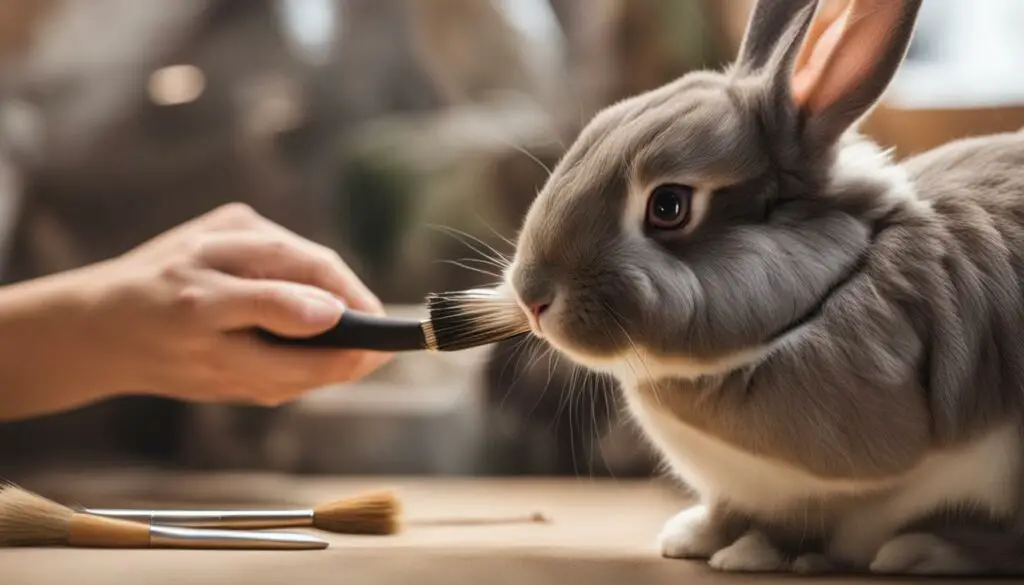
Remember, grooming sessions are not only about maintaining your rabbit’s appearance but also about ensuring their comfort and well-being. Take the time to create a positive grooming experience for your bunny butt, and they will appreciate the love and care you provide.
The Mogwai Myth – Water and Your Bunny Butt
While rabbits are generally self-sufficient when it comes to grooming, there may be instances where bathing your bunny butt becomes necessary. However, unlike the fictional Mogwai creatures, rabbits can be safely wet under specific circumstances. It’s important to approach rabbit bathing with caution and follow proper safety measures to ensure the well-being of your furry friend.
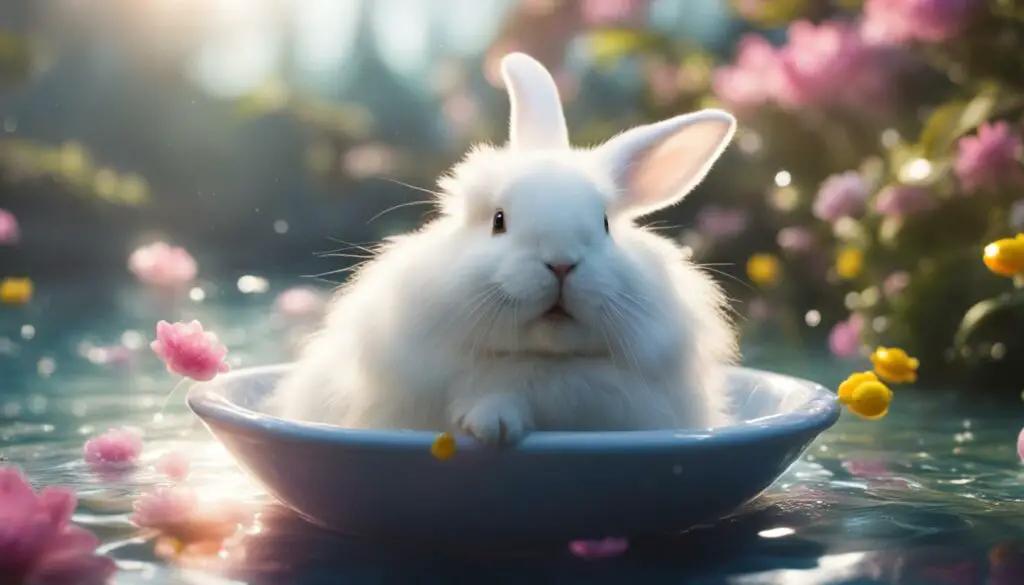
When considering bathing a rabbit, it’s essential to keep in mind that rabbits have delicate respiratory systems. Excessive wetting can lead to chill or hypothermia if not done correctly. Therefore, bathing should only be done when necessary, such as in cases of urine staining or medical reasons, and it’s important to use lukewarm water to prevent any discomfort or shock to the rabbit.
When giving your rabbit a bath, make sure to handle them gently and keep the water temperature lukewarm. Use a suitable rabbit-safe shampoo if needed, ensuring that it is thoroughly rinsed off. After bathing, carefully towel-dry your rabbit to remove excess moisture and prevent them from getting cold. It’s crucial to provide a warm and draft-free environment for your rabbit to dry off completely.
Rabbit Bathing Safety Tips:
- Ensure the water temperature is lukewarm, not too hot or too cold.
- Use rabbit-safe shampoo or opt for plain water if no shampoo is necessary.
- Be gentle and calm when handling your rabbit during bath time.
- Thoroughly dry your rabbit after the bath to prevent chilling.
- Monitor your rabbit closely during and after the bath for any signs of distress or discomfort.
Remember, regular grooming by rabbits themselves is usually sufficient to keep their fur clean and healthy. Bathing should be reserved for specific situations and done with utmost care to ensure your bunny butt stays happy and safe.
Bunny Butt Behaviors – Decoding Your Rabbit’s Actions
Understanding your rabbit’s behaviors is crucial for building a strong bond and ensuring their well-being. Rabbits have unique ways of expressing their emotions and instincts. Here are some common rabbit behaviors explained:
- Rabbit Binkying: Binkying is when a rabbit jumps and twists mid-air, often accompanied by running and twisting. It is a joyful and playful behavior that shows happiness and excitement. Binkying is a sign that your rabbit is feeling content and enjoying their environment.
- Rabbit Thumping: Thumping is a behavior where a rabbit forcefully thumps one or both hind legs against the ground. It can be a warning sign to alert other rabbits or humans of potential danger. Rabbits thump when they sense something unusual or hear loud noises. They use thumping as a way to communicate and protect their territory.
- Rabbit Flopping: Flopping is when a rabbit suddenly goes from an upright position to lying flat on their side or back. It is a behavior that indicates relaxation, comfort, and trust in their environment. Flopping shows that your rabbit feels safe and content.
By observing and understanding these behaviors, you can better respond to your rabbit’s needs and provide them with a happy and enriched life. Remember that each rabbit is unique, so it’s essential to pay attention to your rabbit’s individual behaviors and preferences.
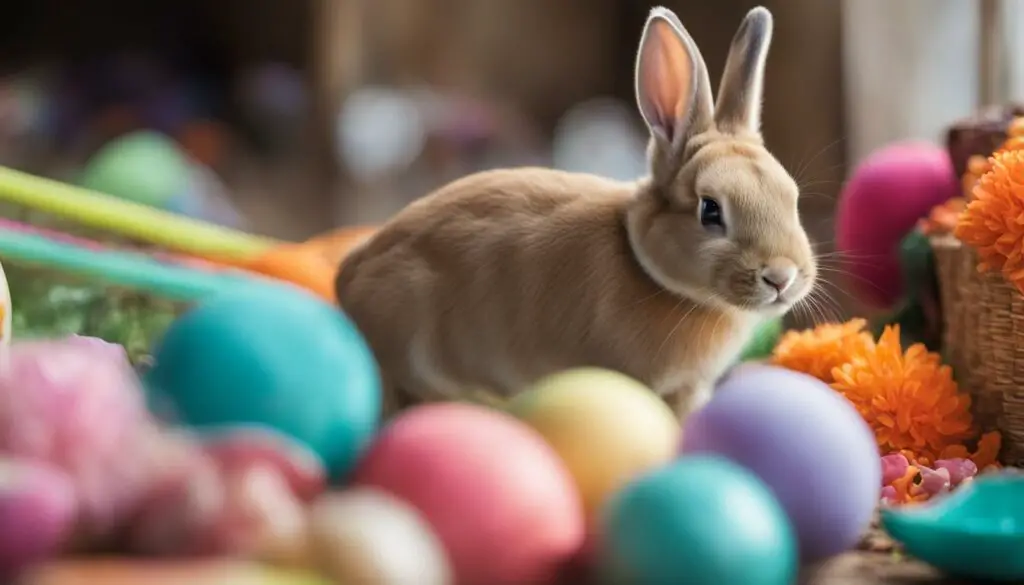
Table: Rabbit Behaviors and Meanings
| Behavior | Meaning |
|---|---|
| Rabbit Binkying | Expression of joy and excitement |
| Rabbit Thumping | Warning sign or response to loud noises |
| Rabbit Flopping | Relaxation and trust in the environment |
Essential Products for Your Bunny Butt
As a responsible rabbit owner, it’s important to provide your bunny butt with the essential products that promote their well-being and happiness. Here are some must-have accessories to consider:
Rabbit Toys
Keeping your rabbit entertained and mentally stimulated is vital for their overall health. Invest in a variety of rabbit toys, such as chew toys, puzzle toys, and interactive toys. These toys not only provide mental stimulation but also help to keep your rabbit’s teeth healthy and prevent boredom.
Rabbit Feeders
Proper feeding is crucial for your bunny butt’s nutrition. Invest in high-quality rabbit feeders that are durable and easy to clean. Hay feeders allow your rabbit to access fresh hay at all times, promoting healthy digestion. Sturdy food bowls or gravity feeders ensure a clean and hygienic feeding environment. Make sure to provide fresh water with water sipper bottles to keep your rabbit hydrated.
Rabbit Enclosures
Your bunny butt needs a safe and spacious enclosure that allows them to move around comfortably. Consider investing in a large rabbit hutch or a pet exercise pen that provides ample space for your rabbit to exercise and explore. The enclosure should be secure and well-ventilated, ensuring the safety and comfort of your furry friend.
By providing your bunny butt with these essential products, you can create a stimulating and comfortable environment that supports their overall well-being. Remember to choose high-quality and rabbit-safe products to ensure the health and happiness of your beloved pet.
Breeding Your Holland Lops – Considerations and Challenges
When it comes to breeding rabbits, there are several considerations and challenges to keep in mind, especially when working with Holland Lops. Breeding rabbits requires a deep understanding of their genetics, temperament, and overall health. Holland Lops, known for their adorable floppy ears, have specific breeding challenges due to their unique characteristics.
One of the main challenges in breeding Holland Lops is their compact size. Being a small breed, it can be more difficult to achieve successful matings and ensure the health and safety of both the dam (female rabbit) and sire (male rabbit). Additionally, the small size of Holland Lop litters means that breeders must be focused on producing quality rather than quantity.
Another challenge in breeding Holland Lops is selecting the right pairings. Breeders must carefully consider the genetic traits they want to preserve and improve in their rabbits. This includes traits such as body shape, ear length, color, and temperament. It is essential to research the pedigrees of potential breeding rabbits and understand the genetic history to make informed decisions.
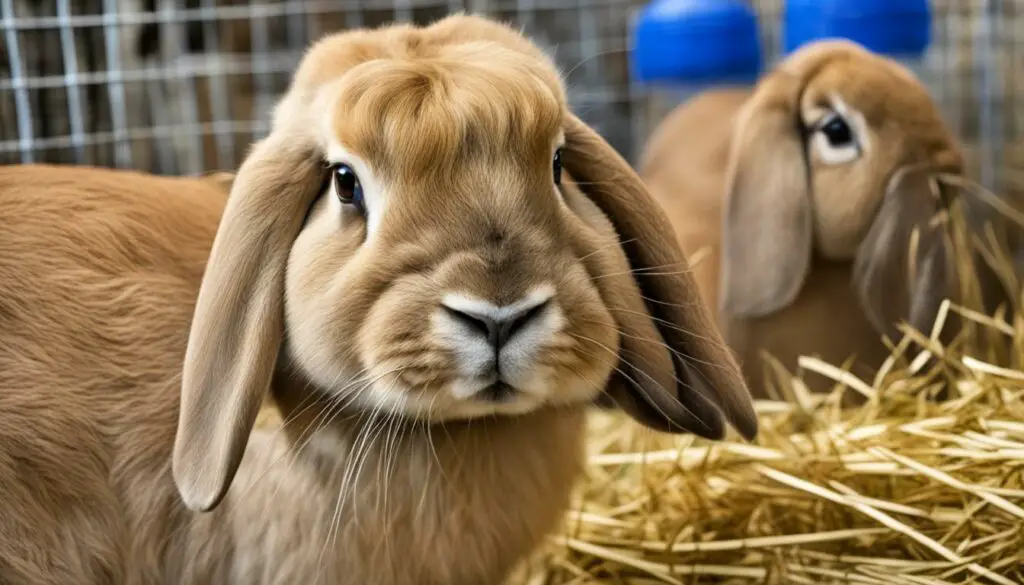
Table: Common Challenges in Holland Lop Breeding
| Challenge | Description |
|---|---|
| Size-related difficulties | Holland Lops being a small breed present challenges in successful matings and ensuring the health of the rabbits involved. |
| Focus on quality | Due to the small size of Holland Lop litters, breeders must prioritize producing high-quality rabbits rather than focusing on quantity. |
| Genetic considerations | Breeders must carefully select pairings, considering the desired genetic traits to preserve and improve in future generations of Holland Lops. |
Overall, breeding Holland Lops requires dedication, knowledge, and attention to detail. It is important to have a thorough understanding of the breed’s unique characteristics and the challenges that come with breeding them. By taking these considerations into account, breeders can work towards producing healthy, genetically sound, and visually stunning Holland Lop rabbits.
Line Breeding – Pros and Cons for Rabbit Breeders
Line breeding, also known as inbreeding, is a breeding strategy commonly used by rabbit breeders. This method involves mating closely related rabbits to preserve desirable traits and produce consistent offspring. However, line breeding comes with its own set of pros and cons that breeders should carefully consider.
Pros of Line Breeding:
- Genetic Preservation: Line breeding allows breeders to maintain and strengthen specific traits within a rabbit lineage. This can be beneficial for preserving desired physical characteristics, temperament, or show attributes.
- Increased Consistency: By breeding closely related rabbits, breeders have a higher chance of producing offspring with consistent traits. This can create a more predictable breeding program and help maintain breed standards.
- Controlled Breeding: Line breeding allows breeders to have greater control over their breeding program. They can carefully select which rabbits to mate based on their desired traits and genetics, leading to more intentional and strategic breeding decisions.
Cons of Line Breeding:
- Genetic Health Risks: One of the main concerns with line breeding is the increased risk of genetic defects and health issues. When closely related rabbits are bred together, there is a higher chance of inherited diseases and weaknesses being passed down to offspring.
- Reduced Genetic Diversity: Line breeding narrows the gene pool within a rabbit lineage, which can lead to reduced genetic diversity. In the long run, this may result in a higher susceptibility to diseases and a decreased ability to adapt to changing environmental conditions.
- Increased Inbreeding Depression: Inbreeding depression refers to the decline in fitness and vitality of offspring resulting from breeding closely related individuals. This can lead to reduced fertility, smaller litter sizes, weakened immune systems, and overall decreased health and vigor in the rabbit population.
It’s important for rabbit breeders to weigh the pros and cons of line breeding before incorporating it into their breeding program. Responsible breeding practices, including careful selection, health testing, and genetic diversity management, can help mitigate the risks associated with line breeding and ensure the long-term health and welfare of the rabbit population.
Additional Care Tips for Your Bunny Butt
When it comes to caring for your bunny butt, there are a few extra tips and tricks that can help ensure their health and happiness. Here are some essential care tips to keep in mind:
Regular Health Checkups
Just like any other pet, rabbits require regular health checkups to ensure they are in top shape. Schedule regular visits with a veterinarian who is experienced in rabbit care. During these checkups, your vet will conduct a thorough examination, including checking your rabbit’s teeth, eyes, ears, and overall body condition. They may also recommend vaccinations and parasite prevention measures.
Maintaining Proper Nail Length
Keeping your bunny’s nails at the right length is crucial for their comfort and well-being. If their nails become too long, it can cause pain and difficulty in movement. Regularly inspect your rabbit’s nails and trim them as needed. Be careful not to cut too close to the quick, as it can cause bleeding and discomfort. If you’re unsure how to properly trim your rabbit’s nails, consult with a veterinarian or a professional groomer.
Safe Handling and Socialization
Proper handling and socialization are essential for your bunny’s emotional well-being. When handling your rabbit, always support their hindquarters to prevent injury. Some rabbits may not enjoy being held, so it’s important to respect their boundaries. Instead, focus on spending quality time with your bunny, providing them with opportunities to hop, explore, and play in a safe and supervised environment. This will help build trust and strengthen your bond with your furry friend.
By following these additional care tips, you can ensure that your bunny butt receives the best possible care and lives a healthy and happy life. Remember, every rabbit is unique, so it’s essential to observe and understand your bunny’s individual needs for personalized care.
Conclusion
Caring for your bunny butt is a rewarding experience that requires dedication and knowledge. By following these rabbit care tips, you can ensure the well-being of your furry friend and build a loving bond together. Remember, rabbits have complex needs, so it’s important to provide a healthy diet with plenty of grass hay and leafy greens. Creating a spacious indoor enclosure or a secure outdoor hutch will give your rabbit the freedom to hop and play.
When bringing your bunny butt home, be patient and allow them time to adjust to their new environment. Gradually introduce interaction and socialization, respecting their pace and preferences. Keep in mind that rabbits are sensitive to temperature, so ensure they have a cool and shaded area during hot weather and proper ventilation indoors. Regular grooming, including brushing their fur and trimming their nails, is essential for their overall health.
Understanding your bunny butt’s behaviors, such as binkying, thumping, and flopping, will deepen your connection and help you meet their emotional needs. Additionally, providing essential products like hay feeders, water sipper bottles, and safe toys will enrich their environment. Remember, breeding rabbits requires careful consideration, and line breeding should be approached responsibly.
In conclusion, by prioritizing bunny butt care and staying attuned to their unique needs, you can provide a happy and fulfilling life for your rabbit. Enjoy the journey of being a responsible rabbit owner and cherish the special moments with your adorable bunny butt!
FAQ
Are rabbits easy pets for beginners?
Contrary to popular belief, rabbits have complex needs and require proper care and attention.
What should rabbits eat?
Rabbits should have a diet consisting of 80% grass hay, leafy green vegetables, and limited pellets.
What size enclosure is suitable for rabbits?
An ideal enclosure for rabbits should allow them to hop freely, lie comfortably, and stand on their hind legs.
How should I introduce my rabbit to their new environment?
Give your rabbit time to adjust and gradually start interacting with them to build trust and familiarity.
Should I keep my rabbit indoors or outdoors?
The decision depends on personal preference and the ability to provide appropriate care for each setting.
How should I ensure my rabbit’s well-being in different temperatures?
Rabbits are sensitive to heat, so it’s important to provide shade and ventilation during hot weather.
How do I groom my rabbit?
Gently brush your rabbit’s fur and trim their nails regularly to keep them healthy and prevent matting.
Can rabbits be bathed?
Bathing should be avoided unless necessary, as rabbits are capable of self-grooming.
What do certain rabbit behaviors mean?
Behaviors like binkying, thumping, and flopping can indicate joy, warning, and relaxation, respectively.
What essential products do rabbits need?
Rabbits require hay feeders, food bowls, water bottles, bedding, and toys for a stimulating environment.
What should I consider before breeding Holland Lop rabbits?
Breeding requires careful consideration and experience, especially when dealing with specific breeds.
What are the pros and cons of line breeding in rabbits?
Line breeding can preserve desirable traits but must be done responsibly to manage potential risks.
What additional care tips should I be aware of?
Regular health checklists, proper nail length, securing and handling your rabbit correctly, and creating a safe home are important aspects of care.
How can I ensure the well-being of my bunny butt?
By following these care tips and being attuned to your rabbit’s needs, you can create a loving and fulfilling relationship with your bunny butt.

